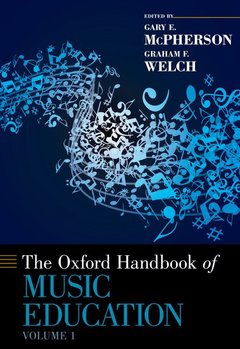Description
The Oxford Handbook of Music Education, Volume 1
Oxford Handbooks Series
Coordinators: McPherson Gary E., Welch Graham F.
Language: English
Subject for The Oxford Handbook of Music Education, Volume 1:
Publication date: 09-2012
992 p. · 18.3x25.6 cm · Hardback
992 p. · 18.3x25.6 cm · Hardback
Description
/li>Contents
/li>Biography
/li>
Music education takes place in many contexts, both formal and informal. Be it in a school or music studio, while making music with friends or family, or even while travelling in a car, walking through a shopping mall or watching television, our myriad sonic experiences accumulate from the earliest months of life to foster our facility for making sense of the sound worlds in which we live. The Oxford Handbook of Music Education offers a comprehensive overview of the many facets of musical experience, behavior and development in relation to this diverse variety of contexts. In this first of two volumes, an international list of contributors discuss a range of key issues and concepts associated with music learning and teaching. The volume then focuses on these processes as they take place during childhood, from infancy through adolescence and primarily in the school-age years. Exploring how children across the globe learn and make music and the skills and attributes gained when they do so, these chapters examine the means through which music educators can best meet young people's musical needs. The second volume of the set brings the exploration beyond the classroom and into later life. Whether they are used individually or in tandem, the two volumes of The Oxford Handbook of Music Education update and redefine the discipline, and show how individuals across the world learn, enjoy and share the power and uniqueness of music.
Handbook Preface. Acknowledgments. External referees. Section 1: Music education and the role of music in people's lives. Section Editor: Graham F. Welch and Gary E. McPherson. Chapter 1: introduction and commentary: Music education and the role of music in people's lives. Graham F. Welch and Gary E. McPherson. Chapter 2: Music's place in education. Wayne Bowman. Chapter 3: International perspectives. Marie McCarthy. Chapter 4: A philosophy of music education. David J. Elliott. Chapter 5: Cultural diversity: Beyond 'songs from every land'. Huib Schippers and Patricia Shehan Campbell. Chapter 6: Some contributions of ethnomusicology. Bruno Nettl. Chapter 7: Musical identities mediate musical development. David J. Hargreaves, Raymond MacDonald and Dorothy Miell. Chapter 8: Supporting motivation in music education. Authors: James M. Renwick and Johnmarshall Reeve. Chapter 9: Becoming a music learner: Towards a theory of transformative music engagement. Susan A. O'Neill. Chapter 10: Initiating music programs in new contexts: In search of a democratic music education. Graca Mota and Sergio Figueiredo. Chapter 11: Implications of neurosciences and brain research for music teaching and learning. Donald Hodges and Wilfried Gruhn. Section 2: Music learning and teaching in infancy and early childhood. Section Editor: Margaret Barrett. Chapter 12: Commentary: Music learning and teaching in infancy and early childhood. Margaret S. Barrett. Chapter 13: Musical lives of infants. Mayumi Adachi (Japan) and Sandra E. Trehub. Chapter 14: Musicality and musical culture: Sharing narratives of sound from early childhood. Colwyn Trevarthen and Stephen Malloch. Chapter 15: Music and language in early childhood development and learning. Lily Chen-Hafteck and Esther Mang. Chapter 16: Musical participation from birth to three: Towards a global perspective. Susan Young and Beatriz Ilari. Chapter 16: Creative meaning-making in infants' and young children's musical cultures. Margaret S. Barrett and Johannella Tafuri. Section 3: Music learning and teaching during childhood: Ages 5-12. Section Editor: Kathryn Marsh. Chapter 17: Commentary: Music learning and teaching during childhood: Ages 5-12. Kathryn Marsh. Chapter 18: Children's ways of learning inside and outside the classroom. Eve Harwood and Kathryn Marsh. Chapter 19: Creating in music learning contexts. Jackie Wiggins and Magne Espeland. Chapter 20: Meaningful connections in a comprehensive approach to the music curriculum. Janet R. Barrett and Kari K. Veblen. Chapter 21: Multiple worlds of childhood: Culture and the classroom. Chee-Hoo Lum and Kathryn Marsh. Chapter 22: Music education in the generalist classroom. Neryl Jeanneret and George DeGraffenreid. Chapter 23: Instrumental ensemble learning and performance in primary school. Sharon G. Davis (USA). Section 4: Music learning and teaching during adolescence: Ages 12-18. Section Editor: Oscar Odena and Gary Spruce. Chapter 24: Commentary: Music learning and teaching during adolescence: Ages 12-18. Gary Spruce and Oscar Odena. Chapter 25: Teaching, learning and curriculum content. Chris Philpott and Ruth Wright. Chapter 26: Youth culture and secondary education. Randall Everett Allsup, Heidi Weste
Gary E. McPherson is Ormond Chair and Director of the Melbourne Conservatorium of Music, University of Melbourne. He is editor of The Science and Psychology of Music Performance (OUP, 2002, with Richard Parncutt) and The Child as Musician: A Handbook of Musical Development (2006). Graham Welch is Chair of Music Education at the Institute of Education, University of London and Deputy Dean of the Institute's Faculty of Culture and Pedagogy. He is elected Chair of the internationally based Society for Education, Music and Psychology Research (SEMPRE) and President of the International Society for Music Education (ISME). His publications number over two hundred and embrace musical development and music education, teacher education, the psychology of music, singing and voice science and music in special education and disability.
© 2024 LAVOISIER S.A.S.

